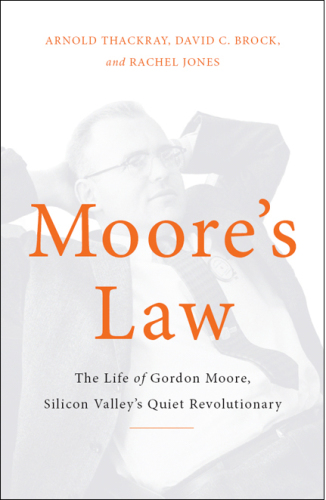
Moore's Law
The Life of Gordon Moore, Silicon Valley's Quiet Revolutionary
کتاب های مرتبط
- اطلاعات
- نقد و بررسی
- دیدگاه کاربران
نقد و بررسی

May 25, 2015
Three writersâThackray, CEO of the Chemical Heritage Foundation; Brock, a leading electronics expert; and Jones, a British journalistâclosely examine the professional and private lives of Gordon Moore, a noted electrical engineer and entrepreneur who helped usher in the Information Age but whose name is rarely heard today. Following Moore's studies at Caltech in 1954, he was recruited by Nobel Prize winner William Shockley to work in his semiconductor research laboratory. Originally impressed by Shockley's methods, Moore later broke away from the bitter squabbles of the lab and resigned with several staff members to start a semiconductor division of military contractor Fairchild, developing a batch process capable of producing multiple transistors from a single silicon wafer. He developed "Moore's Law," describing the rapid pace of transistor miniaturization, while working at Fairchild. In 1968 Moore co-founded the groundbreaking microchip company Intel Corporation. Thackray, Brock, and Jones run through Moore's multifaceted life with a refreshing lack of tech talk or science jargon, revealing a man who realized his dreams while maintaining a stable, affirming personal life. Agent: Melissa Chinchillo, Fletcher & Company.

April 1, 2015
An authorized biography of the little-known chemist who helped create Silicon Valley. Now a billionaire in his mid-80s, Gordon Moore earned his doctorate at Caltech, and in the 1950s and '60s, he created and led two of the nation's most influential technology firms, Fairchild Semiconductor and Intel. He pioneered the chemical process for making transistors-the building bricks in microchips-which power everything in modern society from missiles and satellites to smartphones and other consumer technologies. In this admiring, richly detailed book, Chemical Heritage Foundation founding CEO Thackray (Atoms and Powers, 2013, etc.), electronics journalist Brock, and technology journalist Jones recount Moore's life as "the master of transistor technology and the prophet of the microchip's promise." His "Moore's Law," posited 50 years ago, predicted accurately that computing power will double every two years. In contrast to many Silicon Valley moguls, Moore has long been a quiet, unpretentious figure who has eschewed wealth and fame and lived a practical life guided by facts, not feelings. Based largely on oral history transcripts, the authors tell Moore's story from his childhood as a California sheriff's son to his early work with physicist William Shockley to his tremendous success at Intel, where Andy Grove, his "interpreter, enforcer, and hatchet man," helped him achieve his agenda. They portray a driven, intensely focused scientist and businessman who took comfort in his love of the outdoors and his conventional family life. The silicon transistor is "the object most crafted by humans." By 1995, the 30th anniversary of Moore's declaration of Moore's Law, more than 70 million billion had been produced. This overlong book cries out for further pruning of both text and photos (including 32 featuring Moore, many of them head shots), but techies will be delighted with its full treatment of an important figure often overshadowed by such luminaries as Steve Jobs and Larry Ellison.

May 1, 2015
Almost anyone with a computer has heard of the Intel company. Thackray (founder, Chemical Heritage Fdn.; Joseph Priestley Professor Emeritus, Univ. of Pennsylvania) tells the story of the man who founded and developed the computer giant. In an era in which the innovations of World War II were still pushing the boundaries of science and life, Gordon Moore (b. 1929) exploded into the chemistry universe. He then discovered his true love, the thing that would take him and central California to the top of the semiconductor and processor world: hardware creation. While Intel doesn't come into the text until over half way through, the rich detail of this book gives a picture of life in pre-silicon Silicon Valley. Unlike so many of the personalities that shape modern industry, Moore shaped Intel, his life, and business through strategy and his observation of what is now called Moore's Law: that the number of transistors per square inch on integrated circuits doubles every year. VERDICT Historians, 20th-century scientists, and budding computer revolutionaries will enjoy this study. The events in the book are recent enough that the average person can relate to them and observe the current implications and advances of Moore's transformative technologies.--Dawn Lowe-Wincentsen, Oregon Inst. of Technology, Portland
Copyright 2015 Library Journal, LLC Used with permission.

























دیدگاه کاربران